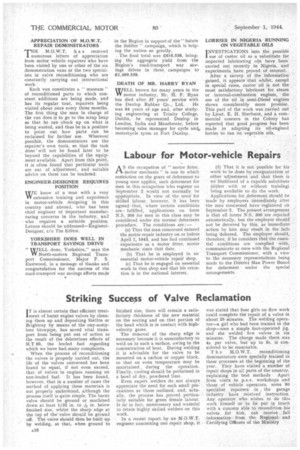Striking Success of Valve Reclamation
Page 18

If you've noticed an error in this article please click here to report it so we can fix it.
IT is almost certain that efficient treatment of burnt engine valves by cleaning them up and depositing Stellite or Brightray by means of the oxy-acetylene blowpipe, has saved vital transport from being put out of action as the result of the deleterious effects of M.T 80, the leaded fuel regarding which we have had, many complaints.
When the process of reconditioning the valves is properly carried out, the life of the valves concerned has been found to equal, if not even exceed, that of valves in engines running on non-leaded fuel. It has been found, however, that in a number of cases the method of applying these materials is not properly understood, although the process itself is quite simple. The burnt valve should be ground or machined down at least 1/32 in. to Ain. below finished size, whilst the sharp edge at the top of the valve should be ground off. The valve should then be built up by welding, so that, when ground to finished size, there will remain a satisfactory thickness of the new material on the seating and on that portion of the head which is in contact with highvelocity gases.
The removal of the sharp edge is necessary because it is unsatisfactory to weld on to such a surface, owing to the concentration of heat. During welding it is advisable for the valve to be mounted on a carbon or copper block, so that an even temperature may be maintained during the operation. Finally, cooling should be performed in a bowl of dry, powdered lime.
Even expert welders do not always appreciate the need for such small precautions as those outlined, and, actually, the process has proved particularly suitable for green female labour. It is: in fact, unnecessary and wasteful to retain highly skilled welders on this work.
In a recent report by an 51.0.W.T. engineer concerning one repair shop, it
was stated that four girls on flow work could complete the repair of a valve in about 20 minutes. The welding operator—a girl who had been trained in the shop—uses a simple foot-operated jig, and she welded five valves in six minutes. The charge made there was 4s. per valve, but up to 5s. is considered to be reasonable.
T h e 111.0.W.T. reconditioning demonstrators were specially trained in these processes at the beginning of the year. They have visited a number of repair shops in all parts of the country.' explaining the best methods Apart from visits to p.s.v. workshops and those of vehicle operators, some 90 specialist repairers in , the garage industry have received instruction. Any operator who wishes to do this work himself or to be put in touch with a concern able to recondition his valves for hire; can receive full information from the Regional and Certifying Officers of the Ministry




















































